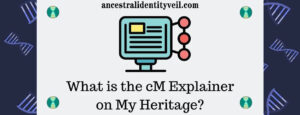Have you encountered MyHeritage’s cM Explainer tool yet? In this post, discover how to access and utilize this useful DNA analysis resource.

At MyHeritage, DNA testing companies are working hard to provide tools that allow us to discover how closely related our DNA matches are to us. They strive to help us better understand their connections.
MyHeritage offers several highly useful DNA analysis tools, and one is called the cM Explainer; anyone can use this helpful analysis tool, even those without results on MyHeritage. Another popular option is Chromosome Browser which is only accessible for those who have taken tests through MyHeritage or uploaded their DNA file onto the website.
What Can The cM Explainer Do For Me? The cM Explainer is a free and simple tool designed to help you figure out your relationship to DNA matches based on the total centimorgans shared, your age and that of their relative. The tool provides both its most likely relationship as well as additional probable ones with probabilities attached.
Example: As an example, I provided information for a DNA match who shared 176 cMs with me and we are roughly similar in age; this tool still works even if you don’t know their age.
The tool found that we are likely second cousins, though there may also be less-likely relationships such as third cousins, half-first cousins once-removed (i.e. the child of our first cousins), etc.
Additionally, the tool results present you with a graphical display to assist in visualizing any possible relationships to DNA matches, including probabilities and shared ancestry information.
Although we cannot know for certain how we are related to most of our DNA matches using only their centimorgan counts as evidence, this tool can help us eliminate less likely relationships so that our efforts can be directed toward researching those most likely.
How Can I Locate the cM Explainer on MyHeritage? Anyone can use MyHeritage’s cM Explainer, even those without DNA results on the platform. Moreover, those who already do upload can also find this tool integrated into their DNA tools dashboard.
If you are already a MyHeritage user, simply log into your account and hover over the DNA tab, selecting DNA Tools from the drop-down menu, then choosing “cM Explainer.” This tool should appear on the left-side screen.
Alternative way of accessing MyHeritage’s cM Explainer tool: Simply visit this link – no MyHeritage account necessary or DNA results stored online are needed to use this feature!
What data forms the basis of the cM Explainer? MyHeritage researchers worked alongside Larry Jones to improve its accuracy by adding MyHeritage specific data sources as inputs into his tool, the cM Solver.
Enhancements to the tool include an age algorithm which assists users in understanding relationship possibilities based on shared DNA and age of both matches. It takes into account average age differences between parents and children in order to provide more accurate probabilities when estimating relationships.
However, this tool provides results and works efficiently even if you do not know or wish to provide age information about your match.
How to use MyHeritage’s cM Explainer tool
Utilizing this tool takes only seconds; simply enter in your total shared DNA centimorgans, your age and that of any matches (if known), and press submit.
Scroll down to view your results.
How to Interpret cM Explainer Results
When we view the cM Explainer results, we first see a list of potential relationships based on DNA shared between people in their family tree (genealogy). These results represent typical levels of shared DNA between these people that could potentially indicate family links (genealogical).
As many of you may already be aware, DNA shares vary among family relationships. Sometimes these overlap to form multiple relationship possibilities using tools such as MyHeritage’s cM Explainer.
Relationship possibilities and their probabilities should be used as a tool to help us narrow down a list of possible family relationships we share with DNA matches, using information such as family tree details or geographical details as tools to decide how related they are to us.
Therefore, while this tool can provide us with a list of relationships and probabilities based on age data for us and our DNA matches, ultimately it’s up to us to further narrow down any possible relationships by initiating conversations with these DNA matches as they might provide additional information that might not appear on their profiles on DNA testing sites. Messaging them could be one way of doing this.
Find more ways to figure out your DNA match here: Are You Related to Your DNA Match? Here Is a Checklist.
Conclusion
I hope this post has provided you with enough knowledge of this new tool available on MyHeritage DNA match list to gain more insight. I look forward to hearing about any discoveries you make using it.
If you have any inquiries or would like to share something that has come up during your exploration of this feature, feel free to let me know by commenting in the section below.
Leave a Reply